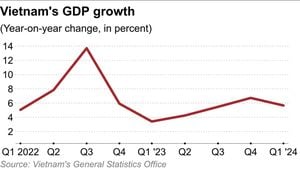With the 2024 presidential election fast approaching, candidates Donald Trump and Kamala Harris are ramping up their campaign efforts, particularly targeting the key swing states of Michigan and Wisconsin. These states are pivotal battlegrounds, having played significant roles in past elections, and both candidates recognize their importance.
On Friday, Trump held rallies where he unleashed aggressive rhetoric, returning to familiar themes, including fear-mongering about immigrants. His words echoed throughout Warren, Michigan, where he continued his staunch criticisms of former Republican Representative Liz Cheney. Trump has previously suggested violent imagery against Cheney, stating, “Let’s put her with a rifle standing there with nine barrels shooting at her.” He positioned himself as not just running against Harris, but against the broader political establishment he claims she embodies.
Harris countered Trump's divisive language with her own strategic messaging aimed at unifying voters. At events across Wisconsin, she emphasized her commitment to serving all constituents, promising to seek common ground. “I pledge to listen to those who will be impacted by the decisions I make,” she asserted at one rally, highlighting her approach as fundamentally different from Trump’s.
Adding to the political spectacle, Harris was joined by pop icon Cardi B at one of her events, where they rallied support from younger voters. Cardi B launched her own impassioned appeal, declaring her disapproval of Trump, stating, “I am not giving Donald Trump a second chance.” The presence of such high-profile endorsers reflects Harris’s push to engage younger demographics, who have shown strong support for Democrats in previous elections.
The campaign actions by both candidates came on the heels of the latest jobs report, which revealed just 12,000 jobs were added to the U.S. economy in October—numbers Trump seized upon to criticize Harris's connection to the administration. He claimed the report illustrated the failures of the current leadership, attempting to frame himself as the solution to the employment crisis.
Despite his aggressive messaging, Trump's strategy seems to include appealing to various demographics, including Arab-American voters, particularly significant in areas like Dearborn, Michigan. Here, Trump faced resistance, as local leaders expressed staunch disapproval, linking his past policies to continued community suffering.
Meanwhile, Harris’s campaign has been proactive, proactively courting communities traditionally aligned with the Democrats—including Black voters, younger generations, and workers. Her outreach efforts have led to more frequent appearances across Michigan compared to other states. Last week, even former President Barack Obama made headlines during his Detroit rally with Eminem—an event crafted to energize viewers and reinforce Democratic solidarity.
The close nature of polling results has ignited both camps' urgency, with many Democrats expressing anxiety over Trump's resurgence. Polls indicate only slight margins between the two candidates, making every rally and public appearance all the more important. Reports have suggested anxiety among Michigan Democrats who are wary of repeating the mistakes of 2016, where they undervalued Trump's appeal.
While the final days before the election are filled with high-stakes campaigning, the choices these candidates make resonate beyond this election. Each campaign strategy reflects their broader visions for America, as they vie for the trust and votes of Americans amid fluctuatings economic conditions.
Overall, with November 5 drawing near, it’s clear both candidates will continue to refine their approaches, using every rally, appearance, and strategic move to win over the hearts and minds of the electorate as they aim for the highest office.



